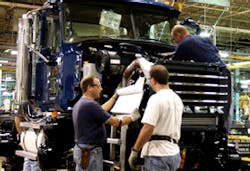The continuing demand for trucks is placing a lot of strain on the capacity of truck OEMs and their suppliers alike, which may lead to even longer lead times for new vehicles as 2005 progresses.
“Realistically, we are at capacity right now,” said Alex Bernasconi, vp-sales for Freightliner LLC. “We could build more trucks to a degree, but we can’t get enough tires, axles, engines, and other components to do so. The industry overall is just tapped out.”
Speaking at a media event held this week at the ConExpo-Con/Agg show in Las Vegas, Bernasconi explained thatincremental efforts to squeeze more trucks out from the industry’s current capacity level is going to be a day-to-day effort, completely dictated by the availability of components.
“We’ve experienced shortages component by component over the last six months, in large part because during the last downturn, a lot of suppliers took capacity out of the market,” he said. “Exhaust tubing, for example, is a problem – our suppliers are at their limit.” He added that while some vocational truck production capacity remains, Class 8 over-the-road plant capacity is completely maxed out.”
Indeed, according to transportation analysis firm A.C.T. Research LLC, there were 7.2 Class 8 trucks backlogged for every single truck built in February. In December there were 7.8 heavy trucks orders pending for every truck that rolled out— the largest logjam since July 1999.
On the medium-duty side, backlogs are much more tame, A.C.T. noted, with the Class 5-7 backlog-to-build ratio at 3.3 in February— a drop from 4.4 in December.
The capacity issue is complicated by the strategic partnerships OEMs have forged with select suppliers over the past several years, making it harder to meet spec’ing requests in the vocational segment, Ray Paradis, director of vocational markets for Peterbilt Motors Co., told Fleet Owner.
“Every manufacturer now has some sort of standard spec in terms of tires, engine, transmission, and axles that is easier to get than others,” he explained. “For example, we’re standard with Caterpillar engines, while International is aligned with Cummins and Freightliner with Detroit Diesel. It’s extremely hard to get engines other than the ones you are standard with because those other brands are trying to keep up with demand from their strategic partners.”
The same holds true for tires, Paradis added. “We’re aligned with Bridgestone/Firestone, and they’ll do everything they can to get us the tires we need,” he said. “By contrast, however, it’s very difficult for us to get Goodyear or Michelin tires because they have other commitments. It’s something we have to work around.”
But despite mounting pressure on OEMs— resulting from expected increasing tonnage, as well as pre-buying before the 2007 federal emissions standards are in place— to boost capacity, truck makers find themselves walking a tightrope. They must satisfy customers’ demand while making measured manufacturing investments.
“We're being a lot more careful with capacity today,” said Paul Vikner, CEO of Mack Trucks. “One of the big mistakes during the last boom cycle in the late 1990s was that we as truck manufacturers added a lot of [plant] capacity and then we were stuck with it. So today we're not going to add capacity unless we either can get the [product] pricing or market longevity to sustain it.”
Vikner said this approach to managing truck manufacturing capacity represents a “healthier” approach to the market, especially in terms of addressing trucking industry vehicle needs over the next five to six years.
“We still have to manage the transition in 2007 and 2010 to new emission rules and the new truck technology that will allow us to meet them,” he said. “There will be some pre-buy I believe to a degree, but that is going to depend on how we as manufacturers address customer concerns about that technology.”
“Capacity is tight today, so the more customization a customer requests for their vehicles, the longer it will take to produce them,” said Bill Sixsmith, director of marketing for International Truck & Engine Corp.'s severe service center. “It can take weeks of extra engineering to meet a customer's specs. For some, that delay is OK, that's what they want. For others, though, it may convince them to look at other spec'ing options. We produce a standard vocational spec for our dealers, so they have that stock available on their lots. That gives the customer a chance to get vehicles for their fleet.”
About the Author
Sean Kilcarr
Editor in Chief
Sean Kilcarr is a former longtime FleetOwner senior editor who wrote for the publication from 2000 to 2018. He served as editor-in-chief from 2017 to 2018.
